--Signs 262, 373, display competence of metal artificers
Kiln, furnace: kō̃da कोँद । कुलालादिकन्दुः f. a kiln; a potter's kiln (Rām. 1446; H. xi, 11); a brick-kiln (Śiv. 1033); a lime-kiln. -bal -बल् । कुलालादिकन्दुस्थानम् m. the place where a kiln is erected, a brick or potter's kiln (Gr.Gr. 165). --khasüñü --खस॑ञू॒ । कुलालादिकन्दुयथावद्भावः f.inf. a kiln to arise; met. to become like such a kiln (which contains no imperfectly baked articles, but only well-made perfectly baked ones), hence, a collection of good ('pucka') articles or qualities to exist. Cf. Śiv. 1033, where the causal form of the verb is used. (Kashmiri) khŏḍ or (El.) khwŏḍ ख्वड् । गर्तः m. (sg. abl. khŏḍa 1 ख्वड ), a pit, a hole dug in the ground (H. x, 13); a ditch (Gr.M.); esp. a hole dug in the ground in which money or other treasure is buried for safety, a pit-hoard; a cavity (El.), a rent (El.). --khanun --खनुन् । विघातः m. to dig a pit (Śiv. 590, 746, 1215); met. to dig a pit (for a person), to lay a trap for his destruction (e.g. by calumniating him to his superiors). Cf. khŏna-waṭh,s.v. khŏn. khŏḍa-onu ख्वड-अ॑नु॒ । अन्धभेदः adj. (f. -üñü -अ॑ञू॒ ), a blind man whose eyeballs are sunken in as if at the bottom of a pit (an appearance presented by persons blind from smallpox, or sometimes by persons born blind).(Kashmiri)
*khuṇṭa2 ʻ corner ʼ. 2. *kuṇṭa -- 2 . [Cf. *khōñca -- ]1. Phal. khun ʻ corner ʼ; H. khū̃ṭ m. ʻ corner, direction ʼ (→ P. khũṭ f. ʻ corner, side ʼ); G. khū̃ṭṛī f. ʻ angle ʼ. <-> X kōṇa -- : G. khuṇ f., khū˘ṇɔ m. ʻ corner ʼ.2. S. kuṇḍa f. ʻ corner ʼ; P. kū̃ṭ f. ʻ corner, side ʼ (← H.).(CDIAL 3898) Ka. gondi, gondu alley, lane, narrow passage in the ocean, strait. Te. gondi corner, lane. (DEDR 2100) Ta. kōṇ crookedness, angle, crossness of disposition; kōṇu (kōṇi-) to be bent, curved, be crooked, deviate, be perverse; kōṇam curve, curvature, scimitar, angle, corner; kōṇal obliquity, hump, crookedness (as of mind); kōṇaṉ humpback; kōṇai curvature, crookedness, cruelty; kuṇaku (kuṇaki-) to become bent, crooked; kuṇakku (kuṇakki-) to bend (tr.); n. crookedness, curvature, crossness; kuṇalai bending of the body through bashfulness; kuṇukku (kuṇukki-) to bend (tr.). Ma. kōṇ corner, angle; kōṇuka to bend (intr.); kōṇam corner; kōṇi corner of a piazza. Ko. go·ṇ corner of room. Ka. kōṇ, kōṇa, kōṇe, kōna angle, corner. Tu. kōṇa, kōṇè id.; kōṅgaṇṇů a squint eye. Te. kōṇamu angle, corner; kōna corner. Ga. P.) kōne corner.
Konḍa (BB) kōna id. Cf. 2054(b) Ta. kōṭi. / Cf. Skt. koṇa- corner, angle, point of the compass; Turner, CDIAL, no. 3504.(DEDR 2209) kōṇa m. ʻ corner, angle ʼ MBh. [Cf. kuṇi -- , *khuṇṭa -- 2 : ← Drav. T. Burrow BSOAS xi 341]Pa. kōṇa -- m., Pk. kōṇa -- , ˚aga -- , m.n. ʻ corner, part of a house ʼ; Sh. (Lor.) kunīˊ ʻ corner ʼ, K. kūn m., P. koṇ, ˚ṇā, kūṇ, ˚ṇā m., WPah. bhal. kōṇi f., cam. kūṇā m., Ku. kuṇo, pl. kwāṇā, gng. &rtodtilde; N. kunu, A. koṇ, B. koṇ, ˚ṇā, Or. koṇa, kuṇa; Bi. kon, ˚nī, konā -- konī ʻ ploughing from corner to corner ʼ; Mth. koniyā ʻ low wall round three sides of winnowing basket ʼ; Bhoj. kōn ʻ corner ʼ, H. kon, ˚nā m., G. kɔṇ m. (X *khuṇṭa -- 2 in kāṭ -- khuṇ = -- koṇ m. ʻ right angle ʼ), M. koṇ m., Si. kona; -- Pk. koṇṇa -- m. ʻ corner of a house ʼ (< kōṇa -- as tella -- < tailá -- ?); M. kon m. ʻ corner ʼ, ˚nā, ˚nyā m. ʻ cornerstone ʼ (prob., despite LM 139, koṇ, not kon, is borrowed).*kōṇakāṣṭha -- , *kōṇasītā -- ; catuṣkōṇa -- , ṣaṭkōṇa -- .Addenda: kōṇa -- : S.kcch. khūṇo m. ʻ corner ʼ, WPah.kṭg. kvṇɔ m., kc. kvṇe f., J. koṇā m., Garh. kōṇū.(CDIAL 3504)
Sign 373 has the shape of oval or lozenge is the shape of a bun ingot. mũhã̄ = the quantity of iron produced atone time in a native smelting furnace of the Kolhes; iron produced by the Kolhes and formed likea four-cornered piece a little pointed at each end; mūhā mẽṛhẽt = iron smelted by the Kolhes andformed into an equilateral lump a little pointed at each of four ends; kolhe tehen mẽṛhẽt komūhā akata = the Kolhes have to-day produced pig iron (Santali). Thus, Sign 373 signifies word, mũhã̄ 'bun ingot'.
The ccentre-piece of a metalworker'sactivities is the kiln, furnace. Many ligatures are shown to embellish the semantics of this artifact as may be seen from scores of variants and signs of Indus Script Corpora signified by the orthography of a rhombus or lozenge, focussed on the 'corner' semantics.
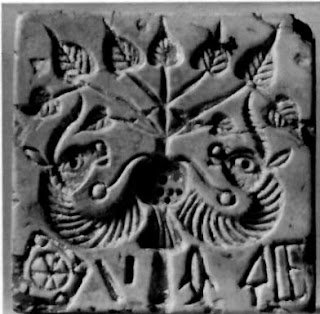
Mohenjo-daro Seal impression. m0296 Two heads of one-horned bulls with neck-rings, joined end to end (to a standard device with two rings coming out of the top part?), under a stylized tree-branch with nine leaves.
P
Hypertext: Pair of rings attached to string, pair of young bulls: dol 'likeness, picture, form' (Santali) dula 'pair' Rebus: dul 'cast iron' (Santali) dul ‘to cast metal in a mould’ (Santali) dul meṛeḍ cast iron (Mundari. Santali) కమ్మరు kammaru or కమరు kammaru. [Tel.] n. A girdle. మొలనూలు. కమ్మరము kammaramu kammaramu. [Tel.] n. Smith's work, iron work. కమ్మరవాడు, కమ్మరి or కమ్మరీడు kammara-vāḍu. n. An iron-smith or blacksmith. బైటికమ్మరవాడు an itinerant blacksmith. कर्मार karmāra m. an artisan , mechanic , artificer, a blacksmith &c ऋग्-वेद RV. x , 72 , 2 AV. iii , 5 , 6 VS. Mn. iv , 215 &c (Monier-Williams)
Thus, semantics of 'metalcasting' should be used to expand the meanings of associated hypertexts of 'young bull' or 'ring' hieroglyphs.
Hieroglyphs which compose the hypertext on m296 are vivid and unambiguous.
Hieroglyph:Nine, ficus leaves: 1.loa 'ficus glomerata' (Santali) no = nine (B.) on-patu = nine (Ta.)
rebus: lo 'iron' (Assamese) loa ‘iron’ (Gypsy) lauha = made of copper or iron (Gr.S'r.); metal, iron (Skt.); lohakāra = coppersmith, ironsmith (Pali);lohāra = blacksmith (Pt.); lohal.a (Or.); loha = metal, esp. copper or
bronze (Pali); copper (VS.); loho, lo = metal, ore, iron (Si.) loha lut.i = iron utensils and implements (Santali)Exact number of nine ficus leaves occur together with a zebu tied to a post, on another artifact of Mehi, a site of the civilization.
Hieroglyph: loa 'a species of fig tree, ficus glomerata, the fruit of ficus glomerata (Santali)
kamaṛkom ‘ficus’ (Santali); Rebus: Ta. kampaṭṭam coinage, coin. Ma. kammaṭṭam, kammiṭṭamcoinage, mint. Ka. kammaṭa id.; kammaṭi a coiner (DEDR 1236)
Hieroglyph: Semantic determinative of portable furnace:
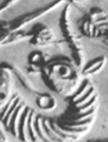 koṭ = neck (Gujarati) koḍ 'horn' koḍiyum ‘heifer’ (G.). Rebus: koṭ ‘workshop’ (Kuwi) koṭe = forge (Santali) kōḍiya, kōḍe = young bull (G.)Rebus: ācāri koṭṭya ‘smithy’ (Tulu) Pair:
koṭ = neck (Gujarati) koḍ 'horn' koḍiyum ‘heifer’ (G.). Rebus: koṭ ‘workshop’ (Kuwi) koṭe = forge (Santali) kōḍiya, kōḍe = young bull (G.)Rebus: ācāri koṭṭya ‘smithy’ (Tulu) Pair: kondh 'young bull' rebus: kũdār 'turner, brass-worker, engraver (writer)' kundaṇa 'fine gold'. Thus apair of young bulls signify the hypertext: dul kundaṇa koḍ 'metalcaster goldsmith workshop'.
Hieroglyph: गोटी [ gōṭī ] f (Dim. of गोटा) A roundish stone or pebble. 2 A marble Rebus: गोटी [ gōṭī ] f (Dim. of गोटा) A lump of silver: as obtained by melting down lace or fringe. Thus, the hypertext reads: dul gōṭī khār 'silver metalcaster smith'.
Rebus: khār 1 खार् । लोहकारः m. (sg. abl. khāra 1 खार ; the pl. dat. of this word is khāran 1 खारन् , which is to be distinguished from khāran 2, q.v., s.v.), a blacksmith, an iron worker (cf. bandūka-khār, p. 111b, l. 46; K.Pr. 46; H. xi, 17); a farrier (El.). This word is often a part of a name, and in such case comes at the end (W. 118) as in Wahab khār, Wahab the smith (H. ii, 12; vi, 17). khāra-basta खार -बस््त । चर्मप्रसेविका f. the skin bellows of a blacksmith. -büṭhü -ब&above;ठू&below; । लोहकारभित्तिः f. the wall of a blacksmith's furnace or hearth. -bāy-बाय् । लोहकारपत्नी f. a blacksmith's wife (Gr.Gr. 34). -dŏkuru । लोहकारायोघनः m. a blacksmith's hammer, a sledge-hammer.; । लोहकारचुल्लिः f. a blacksmith's furnace or hearth. -hāl -हाल् । लोहकारकन्दुः f. , a blacksmith's smelting furnace; cf. hāl । लोहकारकन्या f. a blacksmith's daughter. । लोहकारपुत्रः m. the son of a blacksmith, esp. a skilful son, who can work at the same profession. । लोहकारकन्या f. a blacksmith's daughter, esp. one who has the virtues and qualities properly belonging to her father's profession or caste. -më˘ʦü 1 -म्य&above;च&dotbelow;ू&below; । लोहकारमृत्तिका f. (for 2, see [khāra 3] ), 'blacksmith's earth,' i.e. iron-ore.; । लोहकारात्मजः m. a blacksmith's son. -nay -नय् । लोहकारनालिका f. (for khāranay 2, see [khārun] ), the trough into which the blacksmith allows melted iron to flow after smelting. -ʦañĕ -च्&dotbelow;ञ । लोहकारशान्ताङ्गाराः f.pl. charcoal used by blacksmiths in their furnaces. -wān वान् । लोहकारापणः m. a blacksmith's shop, a forge, smithy (K.Pr. 3). -waṭh -वठ् । आघाताधारशिला m. (sg. dat. -waṭas -वटि ), the large stone used by a blacksmith as an anvil. (Kashmiri)Rebus: khara 'sharp-edged' Kannada); pure, unalloyed (Kashmiri)
Text of the Indus Script inscription m296
 kana, kanac =corner (Santali); Rebus: kañcu, 'bell-metal' (Telugu) कंस mn. ( √कम् Un2. iii , 62), a vessel made of metal , drinking vessel , cup , goblet AV. x , 10 , 5 AitBr. S3Br. &c; a metal , tutanag or white copper , brass , bell-metal (Monier-Williams) kana, kanac =corner (Santali); Rebus: kañcu, 'bell-metal' (Telugu) कंस mn. ( √कम् Un2. iii , 62), a vessel made of metal , drinking vessel , cup , goblet AV. x , 10 , 5 AitBr. S3Br. &c; a metal , tutanag or white copper , brass , bell-metal (Monier-Williams)?nave; erakōlu = the iron axle of a carriage (Ka.M.); cf. irasu (Kannada) [Note Sign 391 and its ligatures Signs 392 and 393 may connote a spoked-wheel, nave of the wheel through which the axle passes; cf. ar ā, spoke]erka = ekke (Tbh. of arka) aka (Tbh. of arka) copper (metal);crystal (Kannada) cf. eruvai = copper (Ta.lex.) eraka, er-aka = any metal infusion (Ka.Tu.); erako molten cast (Tulu) Rebus: eraka = copper (Ka.)eruvai =copper (Ta.); ere - a dark-red colour (Ka.)(DEDR 817). eraka, era, er-a = syn. erka, copper, weapons (Ka.)Vikalpa: ara, arā (RV.) = spoke of wheel ஆரம்² āram , n. < āra. 1. Spoke of a wheel. See ஆரக்கால். ஆரஞ்சூழ்ந்தவயில்வாய்நேமியொடு (சிறுபாண். 253). Rebus: ஆரம்brass; பித்தளை.(அக. நி.) |
 kuṭi = a slice, a bit, a small piece (Santali.Bodding) Rebus: kuṭhi ‘iron smelter furnace’ (Santali) kuṭhī
kuṭi = a slice, a bit, a small piece (Santali.Bodding) Rebus: kuṭhi ‘iron smelter furnace’ (Santali) kuṭhīfactory (A.)(CDIAL 3546)
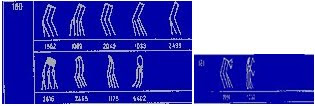 Signs 180, 181 have variants like inlaid warp-pegs within a rhombus with a corner identified. Signs 180, 181 have variants like inlaid warp-pegs within a rhombus with a corner identified.Warp-pegs kor.i = pegs in the ground in two rooms on which the thread is passed back and forth in preparing the warp (S.) Edging, trimming (cf. orthography of glyph in the middle of the epigraph) K. goṭh f., dat. °ṭi f. ʻ chequer or chess or dice board ʼ; S. g̠oṭu m. ʻ large ball of tobacco ready for hookah ʼ, °ṭī f. ʻ small do. ʼ; P. goṭ f. ʻ spool on which gold or silver wire is wound, piece on a chequer board ʼ; N. goṭo ʻ piece ʼ, goṭi ʻ chess piece ʼ; A. goṭ ʻ a fruit, whole piece ʼ, °ṭā ʻ globular, solid ʼ, guṭi ʻ small ball, seed, kernel ʼ; B. goṭā ʻ seed, bean, whole ʼ; Or. goṭā ʻ whole, undivided ʼ, goṭi ʻ small ball, cocoon ʼ, goṭāli ʻ small round piece of chalk ʼ; Bi. goṭā ʻ seed ʼ; Mth. goṭa ʻ numerative particle ʼ; H. goṭ f. ʻ piece (at chess &c.) ʼ; G. goṭ m. ʻ cloud of smoke ʼ, °ṭɔ m. ʻ kernel of coconut, nosegay ʼ, goṭī f. ʻ lump of silver, clot of blood ʼ, °ṭilɔm. ʻ hard ball of cloth ʼ; M. goṭā m. ʻ roundish stone ʼ, °ṭī f. ʻ a marble ʼ, goṭuḷā ʻ spherical ʼ; Si. guṭiya ʻ lump, ball ʼ; -- prob. also P. goṭṭā ʻ gold or silver lace ʼ, H.goṭā m. ʻ edging of such ʼ (→ K. goṭa m. ʻ edging of gold braid ʼ, S. goṭo m. ʻ gold or silver lace ʼ); M. goṭ ʻ hem of a garment, metal wristlet ʼ. Ko. gōṭu ʻ silver or gold braid ʼ.(CDIAL 4271) Rebus: goṭī f. ʻlump of silver' (Gujarati). Decipherment of Sign 236 as a hypertext with two hieroglyph components Sign 180 and Sign 267: 1. warp-pegs (Sign 180) 2. rhombus with corner (Sign 267): Sign 267 is: kancu ʼmũh kharaḍa 'bell metal ingot daybook' PLUS the inlaid Sign 180 (warp-pegs) read rebus: goṭ'hem of a garment' rebus: goṭī f. ʻlump of silver' (G.). Thus, together, the hypertext of Sign 236 reads: goṭī kancu ʼmũh kharaḍa 'silver lump, bell-metal ingot daybook'. An example of Sign 180 may be seen on Mohenjodaro seal m0009. |
Seal m0009 inscription deciphered: Pictorial motif (field symbol): 1, kōḍe, kōnda ‘young bull' (Telugu, Marathi)
2. kōḍ (pl. kōḍul) horn (Pargi)
3. kot.iyum = a wooden circle (ring) put round the neck of an animal; kot. = neck (Gujarati)
4. khōṇḍā 'cowl or hood'
Rebus 1: kōnda ‘engraver', kōndaṇa 'lapidary infixing gems’ working with , kundaṇa 'pure gold'
Rebus 2: koḍ 'artisan's workshop' (Kuwi) koḍ = place where artisans work (Gujarti)
sāṅgaḍa f A body formed of two or more (fruits, animals, men) linked or joined together. The parts joined are: 1.lathe; 2. portable furnace. 1. sāṅgaḍa 'lathe' kunda 'lathe' rebus: kunda 'nidhi of Kubera' PLUS kammaṭamu 'portable furnace' rebus: Ta. kampaṭṭam coinage, coin. Ma. kammaṭṭam, kammiṭṭam coinage, mint. Ka. kammaṭa id.; kammaṭi a coiner. (DEDR 1236). Rebus: jangaḍiyo ‘military guard who accompanies treasure into the treasury’; jāṅgaḍa f (Hindi) Goods taken from a shop, to be retained or returned.
Text of the inscription: rim-of-jar with inlaid three short strokes:
Hypertext 1: kanka 'rim of jar' rebus: karṇī 'supercargo, engraver ' PLUS kolom 'three' rebus: kolimi 'smithy, forge'.
Hypertext 2: gōṭu ʻ silver or gold braid ʼ.(CDIAL 4271) Rebus: goṭī f. ʻlump of silver' (Gujarati).
Hypertext 3: koḍa 'one' rebus: koḍ 'workshop'.
Thus, the inscription reads: kundaṇa kammaṭa sāṅgaḍa goṭī kolimi koḍ karṇī 'gold mint, jangaḍiyo ‘military guard who accompanies treasure into the treasury’, silver lump smithy/forge, (output products entrusted to) supercargo, engraver'.
Sign 274![]() Variant Sign 273
Variant Sign 273![]() The hypertexts are composed of Sign 267
The hypertexts are composed of Sign 267![]() and duplicated Sign 176
and duplicated Sign 176![]() The rebus reading of both signs, Signs 273 and 274 somposed of Sign 267 and duplicated Sign 176 is: kancu ʼmũh dul kharaḍa 'bell metal ingot metal casting daybook'.
The rebus reading of both signs, Signs 273 and 274 somposed of Sign 267 and duplicated Sign 176 is: kancu ʼmũh dul kharaḍa 'bell metal ingot metal casting daybook'.
Hieroglyph: joint of stalk: kāˊṇḍa (kāṇḍá -- TS.) m.n. ʻ single joint of a plant ʼ AV., ʻ arrow ʼ MBh., ʻ cluster, heap ʼ (in tr̥ṇa -- kāṇḍa -- Pāṇ. Kāś.). [Poss. connexion with gaṇḍa -- 2 makes prob. non -- Aryan origin (not with P. Tedesco Language 22, 190 < kr̥ntáti). Prob. ← Drav., cf. Tam. kaṇ ʻ joint of bamboo or sugarcane ʼ EWA i 197] Pa. kaṇḍa -- m.n. ʻ joint of stalk, stalk, arrow, lump ʼ; Pk. kaṁḍa -- , °aya -- m.n. ʻ knot of bough, bough, stick ʼ; Ash. kaṇ ʻ arrow ʼ, Kt. kåṇ, Wg. kāṇ, kŕãdotdot;, Pr. kə̃, Dm. kā̆n; Paš. lauṛ. kāṇḍ, kāṇ, ar. kōṇ, kuṛ. kō̃, dar. kã̄ṛ ʻ arrow ʼ, kã̄ṛī ʻ torch ʼ; Shum. kō̃ṛ, kō̃ ʻ arrow ʼ, Gaw. kāṇḍ, kāṇ; Kho. kan ʻ tree, large bush ʼ; Bshk. kāˋ'n ʻ arrow ʼ, Tor. kan m., Sv. kã̄ṛa, Phal. kōṇ, Sh. gil. kōn f. (→ Ḍ. kōn, pl. kāna f.), pales. kōṇ; K. kã̄ḍ m. ʻ stalk of a reed, straw ʼ (kān m. ʻ arrow ʼ ← Sh.?); S. kānu m. ʻ arrow ʼ, °no m. ʻ reed ʼ, °nī f. ʻ topmost joint of the reed Sara, reed pen, stalk, straw, porcupine's quill ʼ; L. kānã̄ m. ʻ stalk of the reed Sara ʼ, °nī˜ f. ʻ pen, small spear ʼ; P. kānnā m. ʻ the reed Saccharum munja, reed in a weaver's warp ʼ, kānī f. ʻ arrow ʼ; WPah. bhal. kān n. ʻ arrow ʼ, jaun. kã̄ḍ; N. kã̄ṛ ʻ arrow ʼ, °ṛo ʻ rafter ʼ; A. kã̄r ʻ arrow ʼ; B. kã̄ṛ ʻ arrow ʼ, °ṛā ʻ oil vessel made of bamboo joint, needle of bamboo for netting ʼ, kẽṛiyā ʻ wooden or earthen vessel for oil &c. ʼ; Or. kāṇḍa, kã̄ṛ ʻ stalk, arrow ʼ; Bi. kã̄ṛā ʻ stem of muñja grass (used for thatching) ʼ; Mth. kã̄ṛ ʻ stack of stalks of large millet ʼ, kã̄ṛī ʻ wooden milkpail ʼ; Bhoj. kaṇḍā ʻ reeds ʼ; H. kã̄ṛī f. ʻ rafter, yoke ʼ, kaṇḍā m. ʻ reed, bush ʼ (← EP.?); G. kã̄ḍ m. ʻ joint, bough, arrow ʼ, °ḍũ n. ʻ wrist ʼ, °ḍī f. ʻ joint, bough, arrow, lucifer match ʼ; M. kã̄ḍ n. ʻ trunk, stem ʼ, °ḍẽ n. ʻ joint, knot, stem, straw ʼ, °ḍī f. ʻ joint of sugarcane, shoot of root (of ginger, &c.) ʼ; Si. kaḍaya ʻ arrow ʼ. -- Deriv. A. kāriyāiba ʻ to shoot with an arrow ʼ.(CDIAL 3023) Rebus: kaṇḍa 'equipment, metalware'.
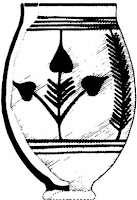 A painted goblet with the 'three-branched fig tree' motif from Nausharo I D, transitional phase between the Early and Mature Harappan periods (c. 2600-2550 BCE) (After Samzun 1992: 250, fig.29.4 no.2)
A painted goblet with the 'three-branched fig tree' motif from Nausharo I D, transitional phase between the Early and Mature Harappan periods (c. 2600-2550 BCE) (After Samzun 1992: 250, fig.29.4 no.2)Sign 327![]()
![]()
![]() V326 (Orthographic variants of Sign 326)
V326 (Orthographic variants of Sign 326) ![]() V327 (Orthographic variants of Sign 327) loa = a species of fig tree, ficus glomerata, the fruit of ficus glomerata (Santali.lex.) Vikalpa: kamaṛkom ‘ficus’ (Santali); rebus: kampaṭṭam ‘mint’ (Ta.) patra ‘leaf’ (Skt.); rebus: paṭṭarai ‘workshop’ (Ta.) Rebus: lo ‘iron’ (Assamese, Bengali); loa ‘iron’ (Gypsy) lauha = made of copper or iron (Gr.S'r.); metal, iron (Skt.); lo_haka_ra = coppersmith, ironsmith (Pali); lo_ha_ra = blacksmith (Pt.); lohal.a (Or.); lo_ha = metal, esp. copper or bronze (Pali); copper
V327 (Orthographic variants of Sign 327) loa = a species of fig tree, ficus glomerata, the fruit of ficus glomerata (Santali.lex.) Vikalpa: kamaṛkom ‘ficus’ (Santali); rebus: kampaṭṭam ‘mint’ (Ta.) patra ‘leaf’ (Skt.); rebus: paṭṭarai ‘workshop’ (Ta.) Rebus: lo ‘iron’ (Assamese, Bengali); loa ‘iron’ (Gypsy) lauha = made of copper or iron (Gr.S'r.); metal, iron (Skt.); lo_haka_ra = coppersmith, ironsmith (Pali); lo_ha_ra = blacksmith (Pt.); lohal.a (Or.); lo_ha = metal, esp. copper or bronze (Pali); copper

 V326 (Orthographic variants of Sign 326)
V326 (Orthographic variants of Sign 326)  V327 (Orthographic variants of Sign 327) loa = a species of fig tree, ficus glomerata, the fruit of ficus glomerata (Santali.lex.) Vikalpa: kamaṛkom ‘ficus’ (Santali); rebus: kampaṭṭam ‘mint’ (Ta.) patra ‘leaf’ (Skt.); rebus: paṭṭarai ‘workshop’ (Ta.) Rebus: lo ‘iron’ (Assamese, Bengali); loa ‘iron’ (Gypsy) lauha = made of copper or iron (Gr.S'r.); metal, iron (Skt.); lo_haka_ra = coppersmith, ironsmith (Pali); lo_ha_ra = blacksmith (Pt.); lohal.a (Or.); lo_ha = metal, esp. copper or bronze (Pali); copper
V327 (Orthographic variants of Sign 327) loa = a species of fig tree, ficus glomerata, the fruit of ficus glomerata (Santali.lex.) Vikalpa: kamaṛkom ‘ficus’ (Santali); rebus: kampaṭṭam ‘mint’ (Ta.) patra ‘leaf’ (Skt.); rebus: paṭṭarai ‘workshop’ (Ta.) Rebus: lo ‘iron’ (Assamese, Bengali); loa ‘iron’ (Gypsy) lauha = made of copper or iron (Gr.S'r.); metal, iron (Skt.); lo_haka_ra = coppersmith, ironsmith (Pali); lo_ha_ra = blacksmith (Pt.); lohal.a (Or.); lo_ha = metal, esp. copper or bronze (Pali); copper(VS.); loho, lo_ = metal, ore, iron (Si.) loha lut.i = iron utensils and implements (Santali.lex.) koṭiyum = a wooden circle put round the neck of an animal; koṭ = neck
(G.lex.) kōṭu = horns (Ta.) kōḍiya, kōḍe = young bull (G.) Rebus: koḍ = place where artisans work (Gujarati)
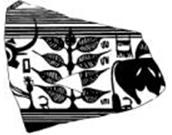
Zebu and nine leaves. In front of the standard device and the stylized tree of 9 leaves, are the black buck antelopes. Black paint on red ware of Kulli style. Mehi. Second-half of 3rd millennium BCE. [After G.L. Possehl, 1986, Kulli: an exploration of anancient civilization in South Asia, Centers of Civilization, I, Durham, NC: 46, fig. 18 (Mehi II.4.5), based on Stein 1931: pl. 30.
पोळ pōḷa, 'zebu, bos indicus' signifies pōḷa 'magnetite, ferrous-ferric oxide Fe3O4',
Semantic determinative: markhor: mẽḍhā 'markhor' rebus: medhā 'yajña, dhanam'; दु mṛdu, mẽṛhẽt, meḍ 'iron' (Santali.Mu.Ho.);med 'copper' (Slavic)mēthí m. ʻ pillar in threshing floor to which oxen are fastened, prop for supporting carriage shafts ʼ AV., °thī -- f. KātyŚr.com., mēdhī -- f. Divyāv. 2. mēṭhī -- f. PañcavBr.com., mēḍhī -- , mēṭī -- f. BhP. 1. Pa. mēdhi -- f. ʻ post to tie cattle to, pillar, part of a stūpa ʼ; Pk. mēhi -- m. ʻ post on threshing floor ʼ, N. meh(e), miho, miyo, B. mei, Or. maï -- dāṇḍi, Bi. mẽh, mẽhā ʻ the post ʼ, (SMunger) mehā ʻ the bullock next the post ʼ, Mth. meh, mehā ʻ the post ʼ, (SBhagalpur) mīhã̄ ʻ the bullock next the post ʼ, (SETirhut) mẽhi bāṭi ʻ vessel with a projecting base ʼ.2. Pk. mēḍhi -- m. ʻ post on threshing floor ʼ, mēḍhaka<-> ʻ small stick ʼ; K. mīr, mīrü f. ʻ larger hole in ground which serves as a mark in pitching walnuts ʼ (for semantic relation of ʻ post -- hole ʼ see kūpa -- 2 ); L. meṛhf. ʻ rope tying oxen to each other and to post on threshing floor ʼ; P. mehṛ f., mehaṛ m. ʻ oxen on threshing floor, crowd ʼ; OA meṛha, mehra ʻ a circular construction, mound ʼ; Or. meṛhī, meri ʻ post on threshing floor ʼ; Bi. mẽṛ ʻ raised bank between irrigated beds ʼ, (Camparam) mẽṛhā ʻ bullock next the post ʼ, Mth. (SETirhut) mẽṛhā ʻ id. ʼ; M. meḍ(h), meḍhī f., meḍhā m. ʻ post, forked stake ʼ.(CDIAL 10317). Rebus: मृदु mṛdu, mẽṛhẽt, meḍ 'metal' mūhā mẽṛhẽt = iron smelted by the Kolhes and formeḍinto an equilateral lump a little pointed at each end; mẽṛhẽt, meḍ ‘iron’ (Mu.Ho.)



